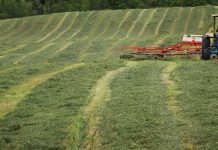Ohio State University might have beaten Penn State in football, but the state of Pennsylvania runs circles around Ohio in its commitment to support and grow its dairy industry.
Last Thursday, a dairy profitability forum was conducted with locations around the state attracting dairy managers and industry folks.
The forum is one example of the collaborative efforts of the Pennsylvania Department of Agriculture, Penn State University Extension and a host of industries pushing to develop a growth industry.
Replacements. A brief, but very important presentation by Mike Evanish of the Pennsylvania Farm Bureau MSC Business Services reiterated why it is so critically important to do a good job raising dairy herd replacements. Bottom line, the herds that had positive internal herd growth were more profitable than herds that had negative internal herd growth.
Let’s look at their numbers:
What pops out at you from this summary? Not a whole lot. And that is the point – there are not any glaring differences in these measures between herds that either sold excess heifers or increased the size of their herds, nor the herds that had to buy cows to maintain and grow their herds.
So what? There were no differences in these basic numbers, but the “so what?” is clear when we look at profitability.
It was 2006, a year of poor milk prices, so the negative net margins are no surprise.
Minimizing damage. However, the herds with positive internal herd growth were able to minimize the damage with an average negative net margin of 23 cents per hundredweight compared to a negative dollar and 47 cents for the herds with negative internal herd growth.
Another way to look at their respective situations is comparing the debt coverage ratios. At 1.41:1, the positive internal herd growth herds had $1.41 available to cover every dollar of debt they had to service.
On average, all of the 522 herds participating in the summary didn’t generate quite enough (97 cents) to cover each dollar of debt. The most stressed herds were the negative internal herd growth herds. They generated only 41 cents to cover every dollar of debt obligation.
Difference. What makes the difference between having enough quality heifers to maintain your herd, then grow herd size or sell extras? Assuming you are not dealing with the aftermath of a 70 percent bull-calf year, every farm can achieve positive internal herd growth.
To achieve positive internal herd growth, the cows have to be well cared for. Keep cull rates to 33 percent or less, the majority being voluntary culls.
At the same time, the calf and heifer programs also have to be someone’s priority. All the articles about calf and heifer care are there because it is absolutely critical that they are fed, housed and cared for to grow, fight off disease challenges and become pregnant in a timely manner.
Balancing the multiple enterprises within a dairy business is a proven recipe for success. Calves, heifers, fresh cows, mid- and late-lactation cows, dry and prefresh cows, nutrition, health and reproduction all play a part in the growth or contraction of your dairy herd.
What may not have been so clear is the huge impact that balance can have on the overall profitability of the dairy farm business.












